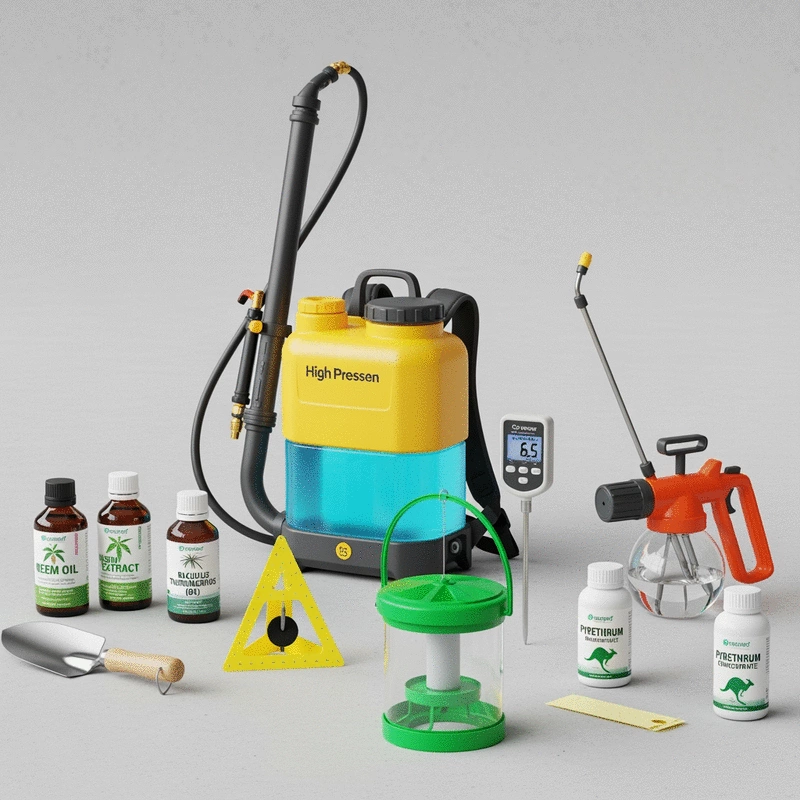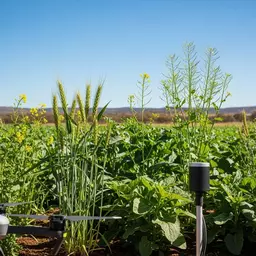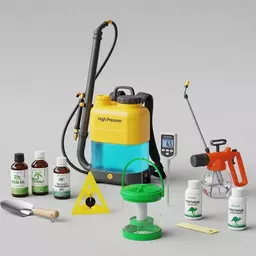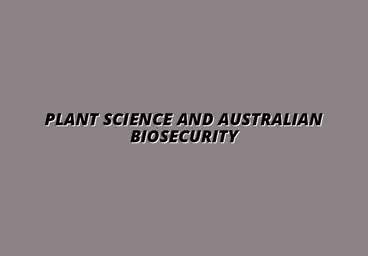Australian Pest Management Tools Guide

As the agricultural landscape in Australia faces mounting challenges, understanding effective crop protection becomes paramount. What if the key to sustainable farming practices lies in a holistic approach that combines innovative strategies? This article unveils essential insights into pest management that every farmer should consider.
What You Will Learn
- Climate change significantly affects pest populations, requiring farmers to adapt their strategies regularly.
- Integrated Pest Management (IPM) combines multiple control methods for a sustainable approach to pest management.
- Understanding the regulatory framework set by the APVMA is crucial for selecting safe and effective pest management solutions.
- Collaboration with agricultural research institutions enhances farmers' access to the latest pest management technologies and training.
Key Pillars of Effective Pest Management in Australia
Integrated Pest Management (IPM) strategies, supported by regulatory frameworks and continuous learning, are crucial for agricultural resilience. For a deeper dive into how these strategies are being implemented, consider exploring resources on sustainable pest control in Australia.
Integrated Pest Management (IPM)
- ✓ Monitoring & Identification for early detection.
- ✓ Biological Control using natural predators.
- ✓ Cultural Practices like crop rotation.
- ✓ Reduced Chemical Use with strategic timing.
Regulatory & Support Frameworks
- ● APVMA: Product Registration & Safety.
- ● Compliance Monitoring for ongoing efficacy.
- ● Research Support & Public Awareness.
- ● Access to latest research and technology.
Farmer Engagement & Education
- ★ Workshops & Training for continuous learning.
- ★ Networking with experts and peers.
- ★ Access to Pest Identification Apps & Tools.
- ★ Local extension services for personalized advice.
Challenges in Pest Management
- ⚠ Climate Change leading to pest outbreaks.
- ⚠ Resistance Development from pesticide overuse.
- ⚠ Regulatory Constraints complicating options.
- ⚠ Resource Limitations for smaller farms.
Understanding Effective Crop Protection in Australia
The landscape of agriculture in Australia is rich and diverse, yet it faces significant challenges when it comes to crop protection. Australian farmers encounter a variety of pests that threaten their yields, impacting not just individual farms but the broader agricultural economy. As a researcher and advocate for sustainable agricultural practices at Plant Frontier Insights, I've seen firsthand how crucial it is to develop effective pest management strategies that align with our commitment to sustainability and resilience.
One of the primary challenges is the varying pest populations that thrive in Australia's unique climate. Farmers must constantly adapt their approaches to deal with invasive species as well as native pests that can fluctuate dramatically from season to season. Addressing these challenges requires a comprehensive understanding of pest behavior, agriculture practices, and timely interventions.
Current Challenges in Pest Management for Australian Farmers
Farmers today are grappling with several pressing issues in pest management:
- Climate Change: Altered weather patterns can lead to unexpected pest outbreaks.
- Resistance Development: Over-reliance on certain pesticides has contributed to pest resistance.
- Regulatory Constraints: Compliance with evolving regulations can complicate pest control options.
- Resource Limitations: Smaller farms often lack access to the latest pest management technologies and research.
These challenges can be daunting, but they also present opportunities for innovation. By leveraging new Integrated Pest Management (IPM) strategies, farmers can better navigate these complexities and strengthen their crop protection efforts.
The Importance of Integrated Pest Management (IPM) Strategies
Integrated Pest Management (IPM) is not just a buzzword; it’s a holistic approach that combines various pest control methods to minimize risks to human health and the environment while maximizing crop yields. At Plant Frontier Insights, we emphasize the significance of IPM as a sustainable solution for Australian agriculture. To learn more about modern scientific advancements that support these strategies, you might find our article on plant science advances in Australia particularly insightful.
- Monitoring and Identification: Regular assessments help identify pest populations early.
- Biological Control: Introducing natural predators can help keep pest numbers in check.
- Cultural Practices: Crop rotation and intercropping can disrupt pest life cycles.
- Reduced Chemical Use: Strategically timing pesticide applications can minimize environmental impact.
The integration of IPM not only leads to healthier ecosystems but also empowers farmers with adaptive strategies. By understanding the web of interactions within their agricultural systems, farmers can make informed decisions that lead us toward a more sustainable future.
Regulatory Framework: Role of the Australian Pesticides and Veterinary Medicines Authority (APVMA)
The Australian Pesticides and Veterinary Medicines Authority (APVMA) plays a critical role in ensuring that pest management solutions are both effective and safe. Understanding the regulatory landscape is essential for farmers who aim to adhere to both safety standards and best practices in pest control.
- Registration of Products: The APVMA assesses the safety and efficacy of pesticides before they can be used.
- Compliance Monitoring: Ongoing evaluations ensure that products remain effective and safe through their lifecycle.
- Research Support: The APVMA collaborates with researchers to promote innovative pest management solutions.
- Public Awareness: They provide resources and guidance to help farmers understand regulations and best practices.
By staying informed about the APVMA's regulations, farmers can select pest management strategies that not only protect their crops but also align with national sustainability goals. It’s an ongoing journey, and I encourage all agricultural professionals to engage with these resources for a more resilient farming future.
Pro Tip
To enhance your Integrated Pest Management (IPM) strategy, consider utilizing pest identification apps that can provide real-time insights into pest populations. These tools enable farmers to make informed decisions and timely interventions, ultimately maximizing crop yields while minimizing environmental impact.
Summarizing Key Insights on Pest Management in Australia
As we reflect on the current landscape of pest management in Australia, it's essential to distill the critical insights that emerge from our discussions. Effective pest management isn't just about combating pests; it’s about creating sustainable practices that empower farmers while safeguarding our ecosystems. Integrated Pest Management (IPM) strategies, for instance, are at the forefront, emphasizing a holistic approach to pest control that combines biological, cultural, and chemical methods.
Moreover, as we've explored, the role of regulatory bodies like the APVMA ensures that farmers have access to safe and effective tools. By adhering to these guidelines, farmers can implement innovative pest management solutions that are both environmentally friendly and economically viable. For further reading on managing potential threats, our article on understanding biosecurity in Australia offers valuable perspectives. This synergy between sustainability and regulation is crucial for the future of Australia's agricultural resilience.
The Path Forward for Sustainable Crop Protection
Looking ahead, the pathway to sustainable crop protection is paved with collaboration and innovation. It's vital for farmers to embrace new technologies and practices that not only protect their crops but also enhance the health of the environment. Here’s how we can all contribute:
- Adopt integrated approaches that combine traditional knowledge with modern science.
- Engage with local research institutions to stay informed on emerging pest management techniques.
- Participate in farmer networks to share insights and experiences.
- Invest in training programs that focus on eco-friendly pest control methods.
By prioritizing these actions, we can build a robust framework for pest management that resonates with our commitment to sustainability. At Plant Frontier Insights, we advocate for a future where farmers are empowered by knowledge and resources, fostering a healthier agricultural landscape for all.
Engagement with Grower Associations and Agricultural Research Institutions
Engagement is key in advancing pest management practices. Collaborating with grower associations and agricultural research institutions enables farmers to access valuable resources and insights. These partnerships can enhance the effectiveness of pest management strategies in several ways:
- Provide access to the latest research and technology.
- Facilitate workshops and training sessions for continuous learning.
- Encourage networking opportunities that foster community support.
- Highlight successful case studies to inspire innovation.
Collaboration not only strengthens the agricultural community but also fosters shared responsibility in tackling pest challenges. At Plant Frontier Insights, we are dedicated to bridging the gap between research and application, empowering farmers with the tools they need to succeed.
Engaging with Pest Management Solutions: Next Steps for Farmers
How to Implement Effective Pest Management Strategies
Implementing effective pest management strategies requires a thoughtful approach tailored to specific crop needs. Here’s a simple framework to guide farmers:
- Assess the current pest situation and identify key pest species.
- Integrate various control methods, including biological and chemical options.
- Monitor pest populations and crop health consistently.
- Adjust strategies based on ongoing assessments and results.
By following these steps, farmers can create a personalized pest management plan that not only addresses immediate challenges but also contributes to long-term sustainability.
Resources and Tools for Ongoing Pest Management Support
Having access to the right resources is crucial for farmers as they navigate pest management. Here are some valuable tools and resources that can enhance pest management efforts:
- Pest identification apps for on-the-go assistance.
- Soil health monitoring tools to support crop resilience.
- Online databases for the latest research and pest management practices.
- Local extension services for personalized support and advice.
Utilizing these resources can empower farmers to make informed decisions and adapt to changing pest dynamics effectively!
Education and Training Programs for Farmers in Pest Management
Finally, education and training programs play an essential role in fostering a culture of sustainable pest management among farmers. Participating in these programs can offer immense benefits:
- Gain hands-on experience and practical skills.
- Stay updated on new regulations and technologies.
- Network with experts and fellow farmers to share experiences.
- Learn about innovative solutions like biopesticides and IPM strategies.
At Plant Frontier Insights, we are passionate about supporting farmers through targeted training opportunities that enhance their pest management practices. Together, we can cultivate a future of agricultural resilience in Australia. For more detailed insights into the financial aspects of pest control, consider reviewing information on pest management costs for farmers.
Frequently Asked Questions About Pest Management in Australia
What is Integrated Pest Management (IPM)?
Integrated Pest Management (IPM) is a holistic approach that combines various pest control methods—such as biological, cultural, and chemical controls—to minimize risks to human health and the environment while maximizing crop yields. It emphasizes monitoring, identification, and strategic interventions.
How does climate change affect pest populations in Australia?
Climate change alters weather patterns, which can lead to unexpected and more frequent pest outbreaks. It can also influence the geographical distribution and life cycles of both native and invasive pest species, requiring farmers to constantly adapt their management strategies.
What role does the APVMA play in Australian pest management?
The Australian Pesticides and Veterinary Medicines Authority (APVMA) is responsible for regulating pesticides and veterinary medicines in Australia. It assesses the safety and efficacy of products, ensures compliance, supports research, and provides resources to help farmers understand regulations and best practices for safe and effective pest control.
Why is farmer engagement and education important for pest management?
Farmer engagement and education are crucial for advancing pest management practices. Through workshops, training, networking, and access to the latest tools and research, farmers can stay informed, share experiences, and adopt innovative, eco-friendly pest control methods, leading to more resilient agricultural systems.
What are some key challenges Australian farmers face in pest management?
Key challenges include adapting to pest outbreaks due to climate change, managing pest resistance from pesticide overuse, navigating complex regulatory constraints, and addressing resource limitations, particularly for smaller farms that may lack access to the latest technologies and research.
Recap of Key Points
- Farmers in Australia face significant challenges in pest management due to climate change, resistance development, and regulatory constraints.
- Integrated Pest Management (IPM) emphasizes a holistic approach by combining monitoring, biological control, and reduced chemical use.
- Understanding the role of the APVMA is essential for farmers to access safe and effective pest management solutions.
- Collaboration with research institutions and grower associations enhances access to resources and innovative pest management techniques.
- Continuous education and training programs are vital for farmers to stay informed about sustainable pest management practices.
Popular Posts
 As the agricultural landscape in Australia evolves, the role of genetic innovation tools becomes inc
As the agricultural landscape in Australia evolves, the role of genetic innovation tools becomes inc
 As the agricultural landscape in Australia faces mounting challenges, understanding effective crop p
As the agricultural landscape in Australia faces mounting challenges, understanding effective crop p
 As Australia faces growing agricultural challenges, the significance of biosecurity cannot be overst
As Australia faces growing agricultural challenges, the significance of biosecurity cannot be overst
 As we delve into the intricate world of biosecurity, consider this: the health of Australia’s ecos
As we delve into the intricate world of biosecurity, consider this: the health of Australia’s ecos
